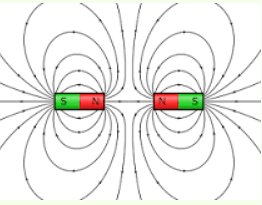Assertion & Reason Test: Magnetic Effects of Electric Current - 2 - Class 10 MCQ
15 Questions MCQ Test Online MCQ Tests for Class 10 - Assertion & Reason Test: Magnetic Effects of Electric Current - 2
Directions: In the following questions, a statement of assertion (A) is followed by a statement of reason (R). Mark the correct choice as:
Assertion : On freely suspending a current - carrying solenoid, it comes to rest in N-S direction just like a bar magnet.
Reason : One end of current carrying straight solenoid behaves as a North pole and the other end as a South pole.
Directions: In the following questions, a statement of assertion (A) is followed by a statement of reason (R). Mark the correct choice as:
Assertion : A compass needle is placed near a current carrying wire. The deflection of the compass needle decreases when the magnitude of an electric current in the wire is increased.
Reason : Strength of a magnetic field at a point near the conductor increases on increasing the current.
| 1 Crore+ students have signed up on EduRev. Have you? Download the App |
Directions: In the following questions, a statement of assertion (A) is followed by a statement of reason (R). Mark the correct choice as:
Assertion : When two bulbs are operated on the same voltage supply, having power 60 W and 100 W then 100 W bulb has less resistance than 60 W.
Reason: The power of the bulb is directly proportional to the square of the voltage.
Directions: In the following questions, a statement of assertion (A) is followed by a statement of reason (R). Mark the correct choice as:
Assertion : An induced e.m.f. appears in any coil in which the current is changing.
Reason : Self induction phenomenon obeys Faraday’s law of induction.
Directions: In the following questions, a statement of assertion (A) is followed by a statement of reason (R). Mark the correct choice as:
Assertion : The magnetic field is stronger at a point which is nearer to the conductor and goes on decreasing on moving away from the conductor.
Reason : The magnetic field B produced by a straight current carrying wire is inversely proportional to the distance from the wire.
Directions: In the following questions, a statement of assertion (A) is followed by a statement of reason (R). Mark the correct choice as:
Assertion: A direction current flows through a metallic rod, producing a magnetic field only outside the rod.
Reason : There is no flow of charge carriers inside the rod.
Directions: In the following questions, a statement of assertion (A) is followed by a statement of reason (R). Mark the correct choice as:
Assertion : Electric appliances with metallic bodies have three connections, whereas an electric bulb has two pin connections.
Reason : Three pin connections reduce heating of connecting wires.
Directions: In the following questions, a statement of assertion (A) is followed by a statement of reason (R). Mark the correct choice as:
Assertion : When two long parallel wires, hanging freely are connected in series to a battery, they come closer to each other.
Reason : Wires carrying current in opposite direction repel each other
Directions: In the following questions, a statement of assertion (A) is followed by a statement of reason (R). Mark the correct choice as:
Assertion : A small coil carrying current, in equilibrium, is perpendicular to the direction of the uniform magnetic field.
Reason : Torque is maximum when the plane of coil and direction of the magnetic field are parallel to each other.
Directions: In the following questions, a statement of assertion (A) is followed by a statement of reason (R). Mark the correct choice as:
Assertion: Basic difference between an electric line and magnetic line of force is that the former is discontinuous and the latter is continuous or endless.
Reason: No electric lines of force exist inside a charged body but magnetic lines do exist inside a magnet
Directions: In the following questions, a statement of assertion (A) is followed by a statement of reason (R). Mark the correct choice as:
Assertion : Two bar magnets attract when they are brought near to each other with the same pole.
Reason : Unlike poles will attract each other.
Directions: In the following questions, a statement of assertion (A) is followed by a statement of reason (R). Mark the correct choice as:
Assertion : In Fleming’s Left Hand Rule, the direction of magnetic field, force and current are mutually perpendicular.
Reason : Fleming’s Left hand Rule is applied to measure the induced current.
Directions: In the following questions, a statement of assertion (A) is followed by a statement of reason (R). Mark the correct choice as:
Assertion : No net force acts on a rectangular coil carrying a steady current when suspended freely in a uniform magnetic field.
Reason : Force on coil in magnetic field is always nonzero.
Directions: In the following questions, a statement of assertion (A) is followed by a statement of reason (R). Mark the correct choice as:
Assertion : A proton moves horizontally towards a vertical long conductor having an upward electric current. It will deflect vertically downward.
Reason : Seeing the proton and the conductor from the side of the proton, the magnetic field at the site of the proton will be towards the right. Hence the force ![]() will deflect the proton vertically downward.
will deflect the proton vertically downward.
Directions: In the following questions, a statement of assertion (A) is followed by a statement of reason (R). Mark the correct choice as:
Assertion : A neutral body may experience a net nonzero magnetic force.
Reason : The net charge on a current carrying wire is zero, but it can experience a force in a magnetic field.
|
461 tests
|


















